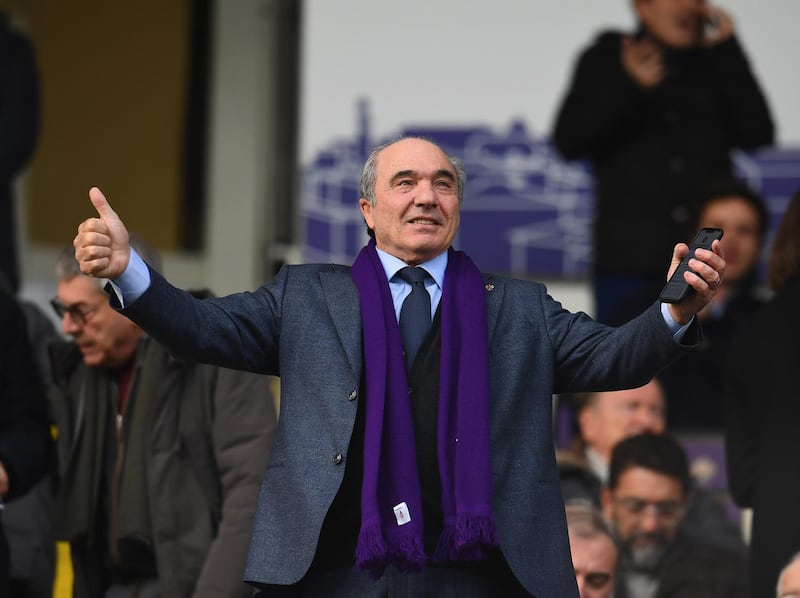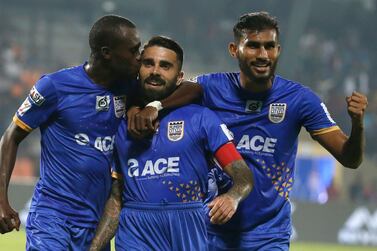“Rocco! Rocco! Rocco!”
The shouts echoed around ACF Fiorentina’s 88-year-old stadium on a Sunday evening in January as the home crowd celebrated a narrow win against Spal that may prove crucial in keeping their team in Italy’s top football league.
The adulation wasn’t for a star player or coach, but for the club’s new owner, Rocco Commisso, the billionaire founder of American cable company Mediacom.
“He is the best president Fiorentina ever had,” said Matteo Cupini, 44, a lifelong fan who attended the game wearing an Uncle Sam Hat. “He is number one.”
Mr Commisso, 70, who grew up in the Bronx and played football for Columbia University, has worked hard to win over supporters since buying the Florence-based club in June.
He’s among a growing group of Americans with ambitions in European football: John Henry’s Fenway Sports Group owns Liverpool, the Glazer family control Manchester United and Stan Kroenke is the moneyman behind Arsenal—three of the world’s most popular teams, who all play in the English Premier League.
Mr Commisso, who was born in Italy, is focusing on Serie A, where the clubs are sometimes in difficult financial situations. Paul Singer’s hedge fund Elliott Management took control of AC Milan, one of Italy’s most successful sides, in 2018 after its Chinese owners defaulted on its debt.
Last weekend, in what’s becoming a home game tradition, Mr Commisso followed the team’s bus into the stadium. Wearing a dark suit and a scarf in Fiorentina’s purple colours, he jumped out of a black Mercedes van and spent half an hour hugging fans and smiling for photos under a picture-perfect blue sky. During the game, he behaved just like one of them, holding his head in his hands at near misses and leaping out of his seat with his arms aloft when Fiorentina scored the winning goal in the last few minutes.
After the final whistle he greeted his players as they made their way back into the dressing room before heading to the stands to celebrate — and participate in yet more selfies. It’s a far cry from the frosty relations the team’s previous owners, Italy’s Della Valle family, had with the fans.
Italy may have storied clubs and beautiful cities, but there’s a faded glamour to many of the teams. They’ve fallen behind English, Spanish and German rivals in commercial, television and match day revenue, held back by ageing stadiums, underwhelming performances in Europe and a more defensive style of play that can alienate some audiences.
That makes the clubs cheaper. Mr Commisso spent about €160 million (Dh651.4m) buying Fiorentina. By comparison, West Ham United, a similarly-ranked team in the English Premier League, had an enterprise value of €578 million, according to KPMG’s European Elite 2019 report.
And that’s for a smaller team. In November, US private equity group Silver Lake bought just over 10% of Manchester City for $500 million (Dh1.84bn). Its primary owner is Abu Dhabi United Group, a company owned by Sheikh Mansour bin Zayed, the emirate's Deputy Prime Minister and Minister of Presidential Affairs.
“Serie A is a very interesting opportunity as you can still enter at a relatively low price,” said Andrea Sartori, global head of sports at KPMG. ”There’s more upside to the valuations of Italian teams.”
Mr Commisso bought Fiorentina in a matter of weeks last summer without doing much due diligence.“I took a calculated risk,” he said in his thick Bronx accent during an interview overlooking the city of Florence on the morning of the match. “Now was the time to act, the price was right and I made the decision.”
Born in southern Italy in 1949, Mr Commisso moved to the US at age 12. The football skills he’d picked up in Europe helped him secure a scholarship to Columbia.
“I was always rough and tough,” he said. “I was the captain. I protected my teammates. I never hurt anybody but I never let anybody hurt me.”
After studying industrial engineering and graduating from Columbia’s business school in 1975, he spent a decade at Chase Manhattan Bank and then Royal Bank of Canada, where he led US lending to media and communication companies.
He joined Cablevision Industries in 1986 and stayed until 1995, when the company was sold. He parlayed his savings into cable company Mediacom, which focused on markets in Midwestern and Southern states.
The company listed on the Nasdaq in 2000 and Mr Commisso took it private 11 years later at an enterprise value of $3.9 billion. “That was the deal of the century,” he said. His stake is now valued at $7.5 billion, according to calculations by Bloomberg.
Football has become an outlet for some of this vast wealth. He bought the New York Cosmos in 2017 and a year later made a bid for AC Milan. He also looked at clubs in England, France, Belgium, Switzerland and the US before buying Fiorentina.
He sees plenty of upside on his Italian investment and is intent on bringing his American business acumen to bear. He’s already announced a €65 million training facility just outside the city and is trying to persuade authorities to let him renovate the ageing concrete bowl of Stadio Artemio Franchi or build a new arena.
“One, whatever we do, just like when I acquired Fiorentina, we’ve got to do it fast,” he said. “Two, at a reasonable cost. Don’t think I’m an uncle from America that came here to be taken advantage of. Three, I need to have control.”
Serie A’s relatively bargain prices reflect the reality of a league stymied by years of underinvestment, the formidable constraints of Italian bureaucracy and regulation, and the deep pockets of rival leagues. The English Premier League pulled in 3.2 billion euros of broadcasting revenue for the 2017-2018 season, more than double Serie A’s 1.3 billion euro haul, according to Deloitte.
“I’m trying to be outspoken and help change the system,” he said. “As a league, we have to increase revenue.”
Mr Commisso’s plans — built on returning Fiorentina to European competition — may also face an existential threat spearheaded by Juventus, Italy’s richest team. Its chairman has proposed a league of European super clubs that could lock out teams like Fiorentina from the continent’s most-lucrative competition.
Even if all of Mr Commisso’s plans come to fruition, there’s no guarantee of sporting success.
Fiorentina’s 1-0 victory against struggling SPAL on Sunday was met with relief by about 33,000 home supporters. A 2-1 victory over high-flying Atalanta in Italy’s annual knockout competition last Wednesday sent them into ecstasy. A 2-0 win over Napoli - one of the clubs that was considered a title contender this year - brought the company up to 13th in the table, on the same number of points as their Neapolitan opponents.
But the next result could just as easily see them despair and the world of sports is littered with the carcasses of owners who’ve sunk money and resources into their teams to no avail. European football is particularly treacherous because, unlike American sports, teams can be relegated to a lower division.
“Even if you’re investing a huge amount of money, that doesn’t mean you’ll be successful on the pitch and fans can still criticise you,” KPMG’s Mr Sartori said.
Mr Commisso is enjoying a honeymoon period with his fans. That may change but, unlike AC Milan’s Elliott or the Glazers of Manchester United, his ties to the club run deeper than the bottom line. He’s an Italian football fan first and foremost. Since buying the club, he’s watched training sessions, hosted press conferences, eaten with the players and gone to every game he can.
“I love it,” he said. “What do you think I’m here for?”







